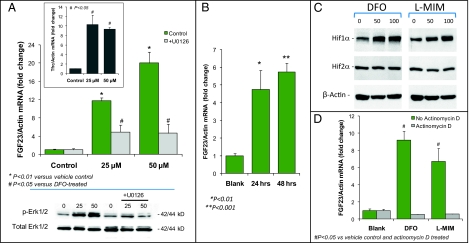Fig. 5.
Regulation of Fgf23 in vitro. (A) (Upper) UMR-106 cells were treated with 25 and 50 μM DFO, resulting at 48 h in dose-dependent increases in Fgf23 mRNA of 12- and 20-fold, respectively (*P < 0.01 vs. vehicle). The Mek inhibitor U0126 (10 μM) blunted the increase in Fgf23 mRNA by more than 70% (#P < 0.05 vs. DFO treatment). (Inset) As a positive control for iron reduction in the cultures by chelation, TfRc1 mRNA was increased over the same treatment course (#P < 0.05 vs. vehicle). (Lower) Western blot analyses of UMR-106 cell lysates demonstrated that p-Erk1/2 was increased at 48 h following 25- or 50-μM DFO treatment. p-Erk1/2 activity was inhibited by U0126 (10 μM); the control total-Erk1/2 was similar across treatments. (B) The EGLN inhibitor l-MIM (50 μM) significantly increased Fgf23 mRNA (*P < 0.01; **P < 0.001). (C) DFO and l-MIM (50 or 100 μM) were associated with stabilized HIF1α but not HIF2α protein. (D) Transcriptional activation of Fgf23 was examined with actinomycin D (0.1 μg/mL) before DFO or l-MIM treatment (24 h). Actinomycin D treatment abolished the Fgf23 mRNA increases (#P < 0.05 vs. both vehicle control and actinomycin D treatment).

